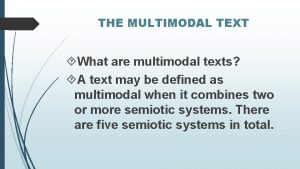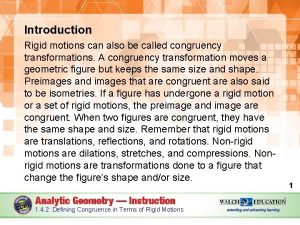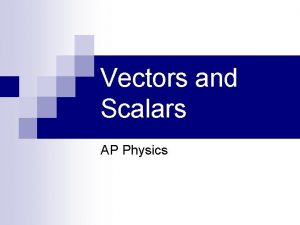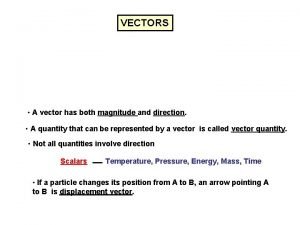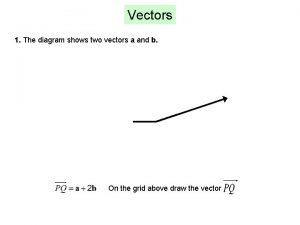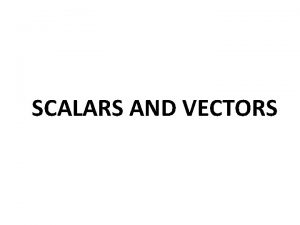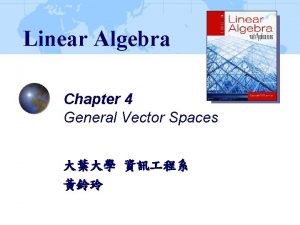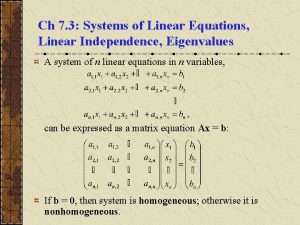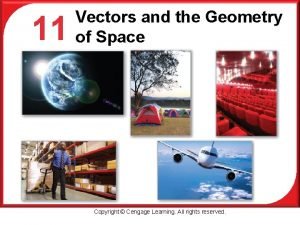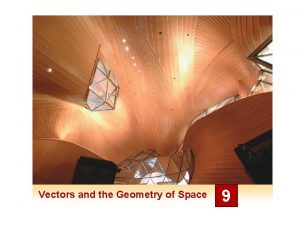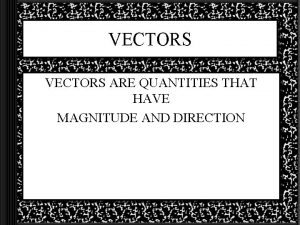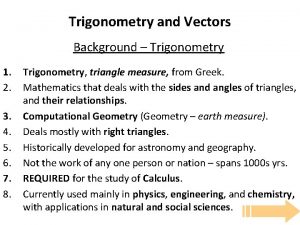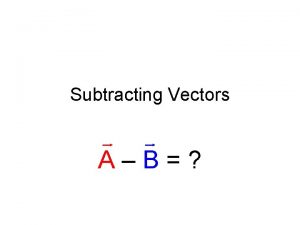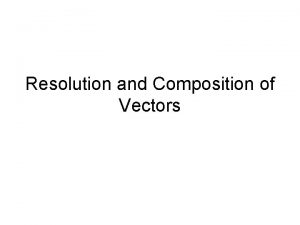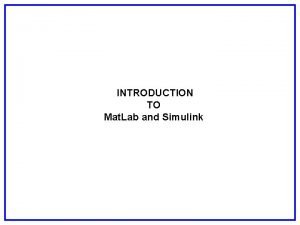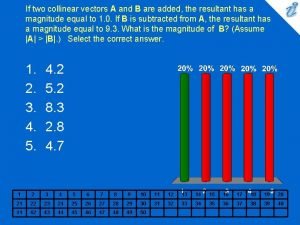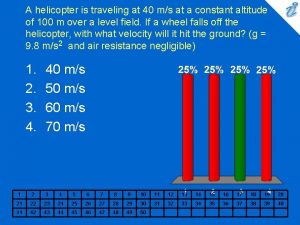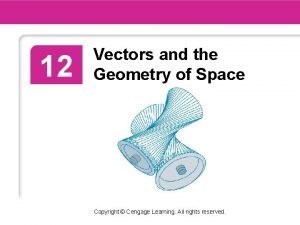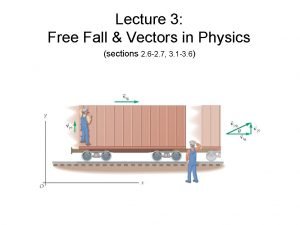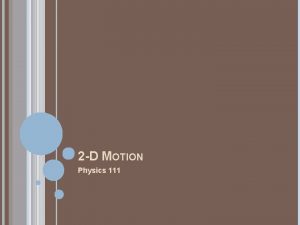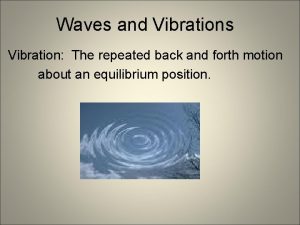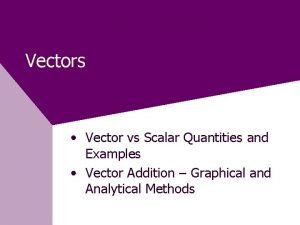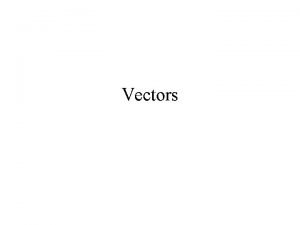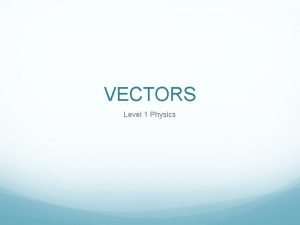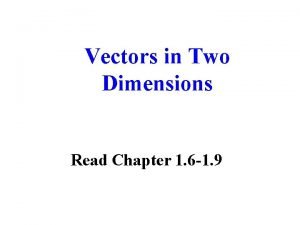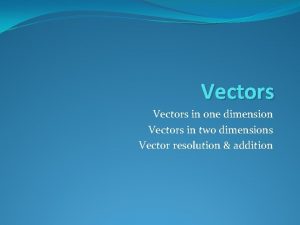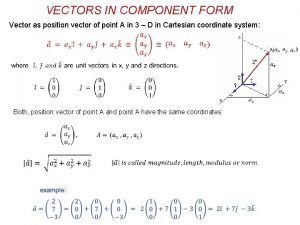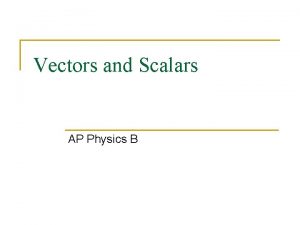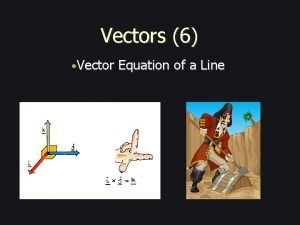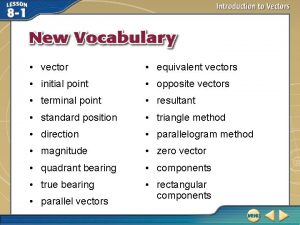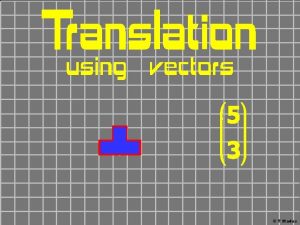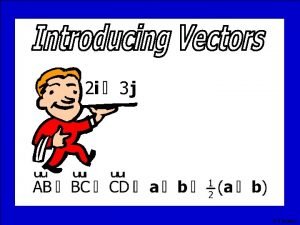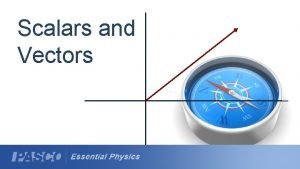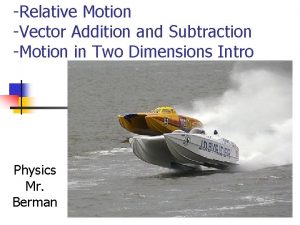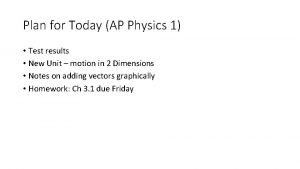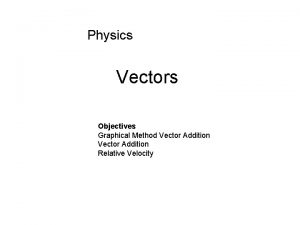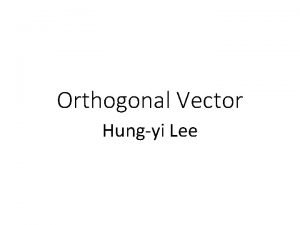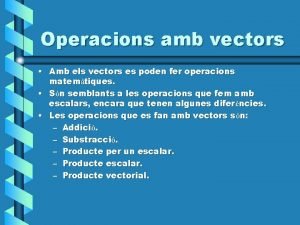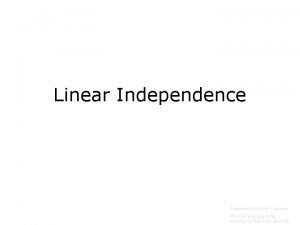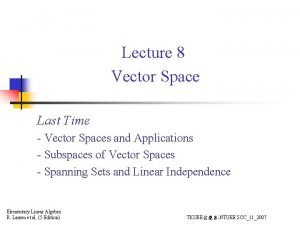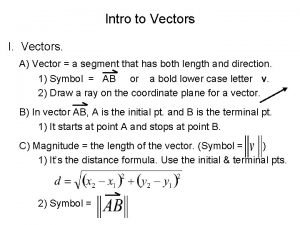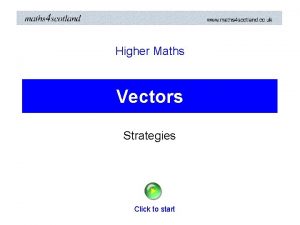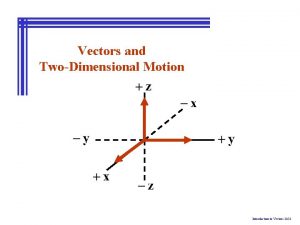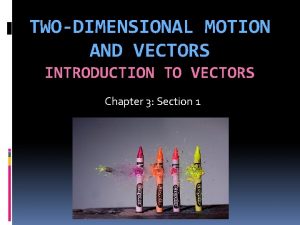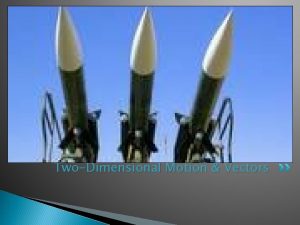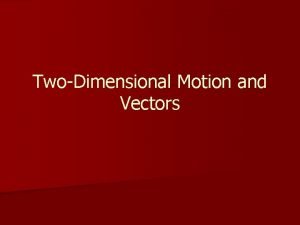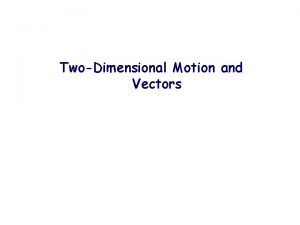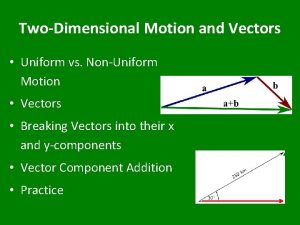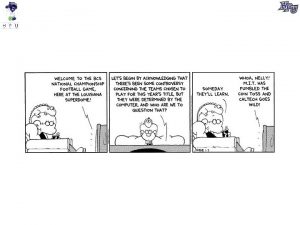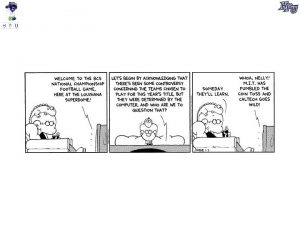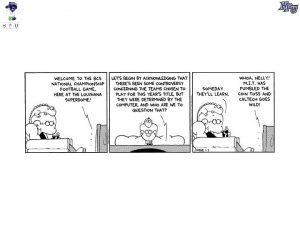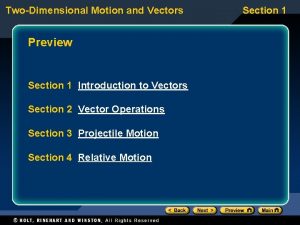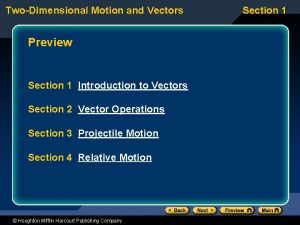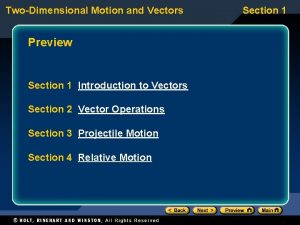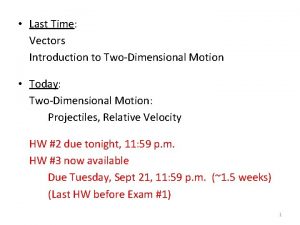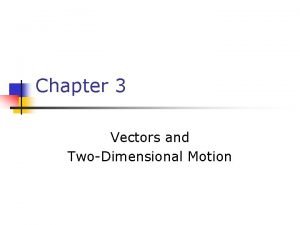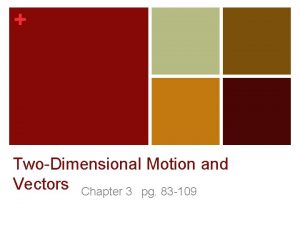Vectors and TwoDimensional Motion Introduction to Vectors 2053







































































- Slides: 71

Vectors and Two-Dimensional Motion Introduction to Vectors 2053

Vectors and Their Properties Magnitude and Direction Magnitude Only Scalars Vectors Distance Time Mass Speed Energy Work Displacement Velocity Acceleration Force Momentum Torque Introduction to Vectors 2053

Vectors and Their Properties Vectors have magnitude and direction Introduction to Vectors 2053

Vectors and Their Properties Two vectors are equal if they have the same magnitude and the same direction Introduction to Vectors 2053

Vectors and Their Properties Vector Addition (Graphical) Introduction to Vectors 2053

Vectors and Their Properties Vector Subtraction (Graphical) Introduction to Vectors 2053

Vectors and Their Properties Vector Subtraction (Graphical) Introduction to Vectors 2053

Vectors and Their Properties Vector Subtraction (Graphical) Introduction to Vectors 2053

Problem 1: A car is driven 125 km due west, then 65 km due south. What is the magnitude of its displacement?

140 km

Problem 2: A shopper walks from the door of the mall to her car 250 m down a lane of cars, then turns 90° to the right and walks an additional 60 m. What is the magnitude of her displacement?

260 m or 300 m

Problem 3: A car moving east at 45 km/h turns west at 30 km/h. What are the magnitude and direction of the change in velocity?

75 km/h east to west

Problem 4: An airplane flies due north at 150 km/h with respect to the air. There is a wind blowing at 75 km/h to the east relative to the ground. What is the plane’s speed with respect to the ground?

170 km/h

Problem 4. 2: An airplane flies due north at 150 km/h with respect to the air. There is a wind blowing at 75 km/h to the east relative to the ground. What is the plane’s velocity with respect to the ground?

Concept Questions 02 -02 Two displacement vectors have magnitudes of 4. 0 m and 7. 0 m, respectively. When these two vectors are added, the magnitude of the resultant (A) is 3. 0 m. (B) is 11 m. (C) could be as small as 3. 0 m, or as large as 11 m. (D) is larger than 11 m. (E) is less than 3 m.

Concept Questions 02 -04 If the acceleration vector of a moving car is directed opposite to the car’s velocity vector (A) the car is turning. (B) the car is speeding up. (C) the car is slowing down. (D) the car is moving with constant speed. (E) the car is stopped.

Problem 5: A car moves 65 km due east, then 45 km due west. What is the car’s total displacement?

20. km east

Problem 6: An airplane flies at 200. 0 km/h with respect to the air. What is the velocity of the plane with respect to the ground if it flies with… a) A 50. 0 km/h tailwind? b) A 50. 0 km/h head wind?

a) 250. km/h b) 150. km/h

Components of a Vector y x Introduction to Vectors 2053

Components of a Vector Components y x Introduction to Vectors 2053

Components of a Vector Components y x Introduction to Vectors 2053

Problem 7: A bus travels 23. 0 km on a straight road that is 30° north of east. What are the east and north components of its displacement?

19. 9 km east 11. 5 km north

Components of a Vector y By R Ry Ay B A x Bx Ax Rx Introduction to Vectors 2053

Components of a Vector y By R Ry B A Ay x Bx Ax Rx Introduction to Vectors 2053

Components of a Vector Adding Vectors F 2 q 2 F 1 q 3 q 4 F 3 Introduction to Vectors 2053

Components of a Vector q 2 F 1 q 3 F 3 q 4 F 1 = 50 N q 1 = 30 o F 2 = 100 N q 2 = 135 o F 3 = 30 N q 3 = 250 o F 4 = 40 N 43. 3 -70. 7 -10. 3 20. 0 -17. 7 25. 0 70. 7 -28. 2 -34. 6 32. 9 q 4 = 300 o Introduction to Vectors 2053

Components of a Vector FR = 37. 4 N q. R 32. 9 f -17. 7 Introduction to Vectors 2053

Problem 8: A GPS receiver told you that your home was 15. 0 km at a direction of 40° north of west, but the only path led directly north. If you took the path and walked 10. 0 km, how far and in what direction would you then have to walk to reach home?

Components of a Vector Add the following vectors q 2 F 2 63. 6 -69. 3 -38. 3 65. 8 21. 8 F 1 q 3 F 1 = 90 N F 2 = 80 N F 3 =50 N F 4 = 70 N q 4 63. 6 40. 0 -32. 1 -23. 9 47. 6 F 4 q 1 = 45 o q 2 = 150 o q 3 = 220 o q 4 = 340 o FR = 52. 4 N 47. 6 q. R 21. 8 Introduction to Vectors 2053

Motion in Two Dimensions Projectile Motion and Relative Velocity

Motion in Two Dimensions ax = 0 ay = -g Projectile Motion and Relative Velocity

Motion in Two Dimensions Projectile: An object with an initial thrust and (ignoring air resistance) moves through the air only under the force of gravity

Motion in Two Dimensions Ignoring air resistance, the horizontal component of a projectile's acceleration (A) is zero. (B) remains a non-zero constant. (C) continuously increases. (D) continuously decreases.


Projectile Motion • A projectile launched horizontally has no initial vertical velocity. • Its vertical motion is like that of a dropped object. • Its only acceleration is due to gravity. • Therefore, it has a constant horizontal speed. • Its horizontal acceleration is zero. • Its vertical speed increases as it falls. • Its vertical acceleration is -9. 80 m/s 2.

Motion in Two Dimensions Problem 9: A stone is thrown horizontally at 15 m/s from the top of a cliff 44 m high. a) How far from the base of the cliff does the stone hit the ground? b) How fast is it moving the instant before it hits the ground?

Motion in Two Dimensions a) 45 m b) 33 m/s

Concept Questions 02 -01 You are trying to cross a river that flows due south with a strong current. You start out in your motorboat on the east bank desiring to reach the west bank directly west from your starting point. You should head your motorboat (A) due west. (B) due south (C) due north. (D) in a southwesterly direction. (E) in a northwesterly direction.

Motion in Two Dimensions Ignoring air resistance, the horizontal component of a projectile's velocity (A) is zero. (B) remains constant. (C) continuously increases. (D) continuously decreases.

Motion in Two Dimensions If an object is launched at an initial angle of θ 0 with the horizontal, the analysis is similar except that the initial velocity has a vertical component. q

Projectiles Launched at an Angle • The initial velocity has both a vertical and a horizontal component. • It rises upward with a slowing vertical velocity. • It continues downward with an increasing vertical velocity. • The vertical speed that it hits the ground with is the same speed that it left the ground. It’s just in the opposite direction (change the sign for velocity). • Its vertical acceleration remains 9. 80 m/s 2 throughout. • Its horizontal velocity remains constant. • Its horizontal acceleration remains zero.

Motion in Two Dimensions A ball is thrown with a velocity of 20. m/s at an angle of 60° above the horizontal. What is the horizontal component of its instantaneous velocity at the exact top of its trajectory? (A) 10. m/s (B) 17 m/s (C) 20. m/s (D) zero

Motion in Two Dimensions A soccer ball is kicked with a velocity of 25 m/s at an angle of 45° above the horizontal. What is the vertical component of its acceleration as it travels along its trajectory? (A) 9. 80 m/s 2 downward (B) (9. 80 m/s 2) × sin (45°) downward (C) (9. 80 m/s 2) × sin (45°) upward (D) (9. 80 m/s 2) upward

Max height, range and hang time

Problem: A ball is launched with an initial velocity of 4. 47 m/s at an angle of 66° above the horizontal. a. What was the maximum height the ball attained? b. How long did it take the ball to return to the launching height? c. What was its range?


Motion in Two Dimensions When a football in a field goal attempt reaches its maximum height, how does its speed compare to its initial speed? (A) It is zero. (B) It is equal to its initial speed. (C) It is greater than its initial speed. (D) It is less than its initial speed.

Concept Questions 02 -05 A soccer ball is kicked from the ground five times with the same initial speed. Each kick is made at a different angle, above the horizontal. For which two kicks will the ball travel the same distance in the air? (A) 25 o and 45 o (B) 45 o and 55 o (C) 55 o and 60 o (D) 15 o and 85 o (E) 35 o and 55 o

Motion in Two Dimensions At what angle should a water-gun be aimed in order for the water to land with the greatest horizontal range? (A) 0° (B) 30° (C) 45° (D) 60°

EOC Problem 03 -22 A football is kicked at ground level with a speed of 18. 0 m/s at an angle of 35. 0º to the horizontal. How much later does it hit the ground? Time in the air is twice the time to the top.

Concept Questions 02 -03 A ball is thrown with an initial velocity (v) at an angle (q) above the horizontal. The horizontal component of its instantaneous velocity at the top of its trajectory is (A) v cos(q) (B) v (C) v sin(q) (D) zero (E) v tan(q)

EOC Problem 03 -18 A diver running 1. 8 m/s dives out horizontally from the edge of a vertical cliff and 3. 0 s later reaches the water below. v a) How high was the cliff? y d b) How far from its base did the diver hit the water?

EOC Problem 03 -04 V q If Vx = 6. 80 units and Vy = -7. 40 units, a) determine the magnitude of V. V y b) determine the direction of V V

Equations to follow

Motion in Two Dimensions y Constant velocity vo q x Sub Eq 1 Eq 3 Projectile Motion and Relative Velocity

Motion in Two Dimensions y Constant acceleration vo At t = 0 q x Constant velocity Eq 1 Eq 2 Projectile Motion and Relative Velocity

Motion in Two Dimensions y Constant acceleration vo q x Eq 4 Projectile Motion and Relative Velocity

EOC Problem 03 -30 A projectile is fired with an initial speed of 65. 2 m/s at an angle of 34. 5º above the horizontal on a long flat firing range. Determine (a) the maximum height reached by the projectile. (b) the total time in the air (c) the total horizontal distance covered (that is, the range).

Motion in Two Dimensions Vertical Position as a Function of Horizontal Displacement y vo q h x Solve Eq 3 for t Sub into Eq 4 Eq 5 Projectile Motion and Relative Velocity

Motion in Two Dimensions Maximum Height y vo q h x Sub into Eq 4 At the maximum height (vy = 0) Eq 6 Eq 7 Projectile Motion and Relative Velocity

Motion in Two Dimensions y Range vo q h x R Eq 8 Projectile Motion and Relative Velocity

Equations Horizontal Velocity Eq 1 Vertical Velocity Eq 2 Horizontal Displacement Eq 3 Vertical Displacement Eq 4 Projectile Motion and Relative Velocity

Equations Vertical Position Eq 5 Time to the Top Eq 6 Maximum Height Eq 7 Range Eq 8 Projectile Motion and Relative Velocity

Relative Velocity d L vw v. B v. S Projectile Motion and Relative Velocity

Relative Velocity Time required to go directly across. vw L v. B q v. S Projectile Motion and Relative Velocity
 Kinematics 2d formulas
Kinematics 2d formulas What is active rom
What is active rom Simple harmonic motion formulas
Simple harmonic motion formulas An object in motion stays in motion
An object in motion stays in motion Chapter 2 section 1 describing motion answer key
Chapter 2 section 1 describing motion answer key What is acceleration
What is acceleration Motion section 1 describing motion
Motion section 1 describing motion Describing motion section 1 answer key
Describing motion section 1 answer key Motion section 1 describing motion
Motion section 1 describing motion Big ed mona multimodal text
Big ed mona multimodal text Introduction to motion
Introduction to motion Introduction rigid motion or isometry
Introduction rigid motion or isometry Unit vector example
Unit vector example Vectors and scalars in physics
Vectors and scalars in physics Tan-1(ry/rx)
Tan-1(ry/rx) Components of vectors
Components of vectors The vector has both magnitude and
The vector has both magnitude and The diagram shows a regular hexagon and a parallelogram
The diagram shows a regular hexagon and a parallelogram Scalar and vector quantities
Scalar and vector quantities Scalars and vectors
Scalars and vectors Vector space definition
Vector space definition Linearly dependent and independent vectors
Linearly dependent and independent vectors Vectors and the geometry of space
Vectors and the geometry of space Conditions for linear independence
Conditions for linear independence Find the scalar and vector projections of b onto a
Find the scalar and vector projections of b onto a Vectors form 3
Vectors form 3 A 100 lb weight hangs from two wires
A 100 lb weight hangs from two wires Vectors are quantities that have magnitude only
Vectors are quantities that have magnitude only Vectors trigonometry
Vectors trigonometry The diagram shows two vectors that point west and north.
The diagram shows two vectors that point west and north. Composition of vectors
Composition of vectors Mat lab matrix
Mat lab matrix Collinear vector
Collinear vector Chapter 12 vectors and the geometry of space solutions
Chapter 12 vectors and the geometry of space solutions Units physical quantities and vectors
Units physical quantities and vectors Physical quantity
Physical quantity Physical quantities and vectors
Physical quantities and vectors A helicopter is traveling at 40m /s
A helicopter is traveling at 40m /s Vectors and the geometry of space
Vectors and the geometry of space 8-5 dot and cross products of vectors in space
8-5 dot and cross products of vectors in space Define instantaneous acceleration
Define instantaneous acceleration You are adding vectors of length 20 and 40 units
You are adding vectors of length 20 and 40 units Intro paragraph layout
Intro paragraph layout A repeated back and forth motion
A repeated back and forth motion Xss vectors
Xss vectors Example of vectors
Example of vectors A vector is a quantity that has
A vector is a quantity that has Collinear vectors example
Collinear vectors example Vectors in 2 dimensions
Vectors in 2 dimensions Vectors in two dimension
Vectors in two dimension Component form of a vector
Component form of a vector Decomposing vectors
Decomposing vectors Carl yaztremski
Carl yaztremski Parallel vectors
Parallel vectors Equivalent vectors
Equivalent vectors Chickering's seven vectors
Chickering's seven vectors Sliding vector
Sliding vector Madas vectors
Madas vectors Madas vectors
Madas vectors Adding displacement vectors
Adding displacement vectors Example for like parallel forces
Example for like parallel forces Adding velocity vectors
Adding velocity vectors Ap physics vectors test
Ap physics vectors test Graphical vector addition
Graphical vector addition Orthogonal vectors
Orthogonal vectors Operacions amb vectors
Operacions amb vectors Linear independence of vectors
Linear independence of vectors Norm van een vector
Norm van een vector Dimension of a vector space
Dimension of a vector space Intro to vectors
Intro to vectors Ib math vectors
Ib math vectors Higher maths exact values table
Higher maths exact values table









